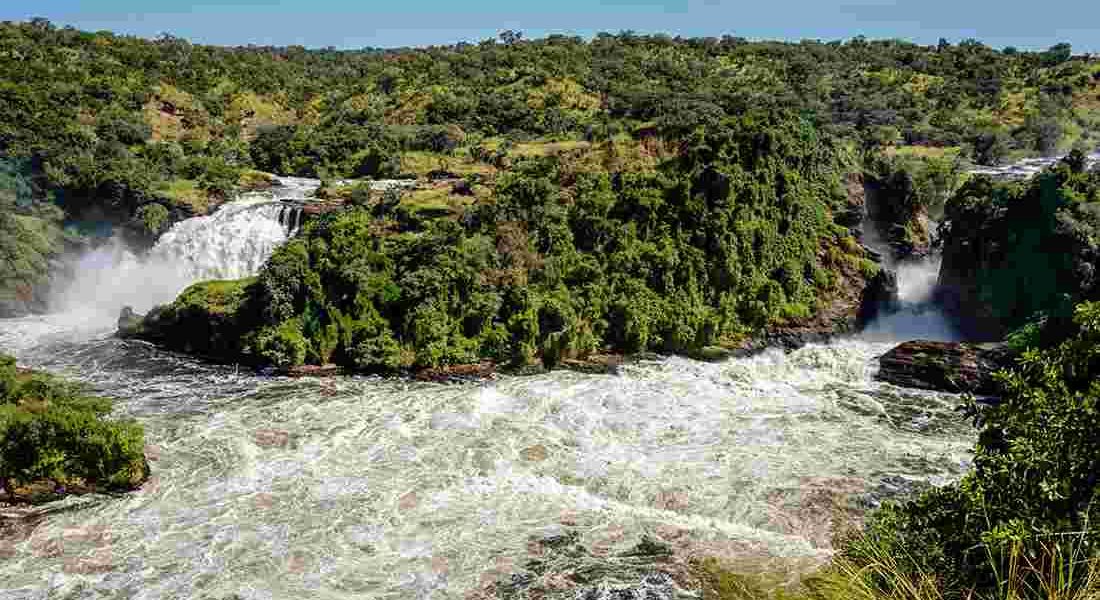Introduction
The River Nile — the world’s longest river — is not just a geographical marvel, it is the pulsing artery of Uganda’s Murchison Falls National Park. Flowing majestically through the heart of the park, the Nile shapes everything it touches: ecosystems, wildlife movements, local communities, and tourism.
From the dramatic plunge of Murchison Falls to the tranquil wetlands of the Nile Delta, this mighty river feeds forests, sustains grasslands, and provides sanctuary to a remarkable diversity of wildlife. In this article, we explore how the Nile serves as the lifeblood of Murchison Falls’ ecosystems, and why it’s essential to the park’s past, present, and future.
Ecosystems of Murchison Falls
Nile River Facts – National Geographic
A River of Life: Nile Geography in the Park
The Victoria Nile — a major tributary of the Nile — enters Murchison Falls National Park from Lake Kyoga, winding westward for 120 kilometers before emptying into Lake Albert.
Key Segments of the Nile in the Park:
- The Falls Section: Where the Nile squeezes through a 7-meter gorge at Murchison Falls
- The Nile Delta: A wide expanse of papyrus and wetlands leading to Lake Albert
- Upstream tributaries and oxbow pools: Smaller offshoots supporting microhabitats
Murchison Falls Waterfall Experience
How the Nile Shapes Biodiversity
The Nile provides year-round freshwater, making Murchison Falls one of the most resilient and diverse ecosystems in East Africa.
1. Aquatic Life
- Hippos: Hundreds of them wallow in the slow-flowing sections
- Nile crocodiles: Among the largest on the continent
- Fish species: Including tilapia, catfish, and tigerfish (vital for local fishing)
Freshwater Fish of the Nile – FishBase
2. Birdlife
- African fish eagles, Goliath herons, shoebill storks, and kingfishers thrive along the riverbanks
- Seasonal migratory birds also nest in the Nile Delta wetlands
Birdwatching in Murchison Falls
3. Mammals
- Elephants, buffaloes, and antelope come to drink, especially during dry seasons
- Predators like lions and leopards patrol the riverbanks for hunting
Wildlife Viewing in Murchison Falls
The Falls: Natural Wonder and Ecological Barrier
At the center of it all is Murchison Falls, where the Nile narrows and drops 43 meters through a rock cleft. This thundering waterfall:
- Creates distinct upstream and downstream ecosystems
- Serves as a natural filter and oxygenation point for river water
- Inhibits fish migration, causing endemic evolution of some aquatic species
Hydrology of the Nile – Water Encyclopedia
The Delta: Cradle of Avian and Aquatic Diversity
As the Nile flows toward Lake Albert, it widens into the Nile Delta, a lush papyrus-filled floodplain.
Ecological Importance:
- Home to the rare shoebill stork
- Natural nursery for fish and amphibians
- Acts as a flood buffer, reducing erosion and absorbing rainfall runoff
Shoebill Stork Safari
Wetlands and Biodiversity – Ramsar
Ecosystem Services Provided by the Nile
The Nile doesn’t just support wildlife — it provides ecosystem services that benefit both the environment and local people.
| Service Type | Examples |
|---|---|
| Provisioning | Water, fish, medicinal plants |
| Regulating | Climate regulation, flood control, soil fertility |
| Supporting | Biodiversity, habitat creation |
| Cultural | Sacred to communities, ecotourism value |
Cultural Sites in Murchison Falls
Tourism and the Nile: Economic Lifeline
Tourism around the Nile is a major economic driver for Murchison Falls and Uganda at large.
Top Nile-Based Activities:
- Boat safaris to the base of Murchison Falls
- Delta cruises for birdwatching and shoebill tracking
- Sport fishing for Nile perch
- Photography tours capturing riverscapes, sunsets, and wildlife at water’s edge
Top Safari Activities Murchison Falls
Uganda Tourism Board – Nile Tours
Threats to the Nile Ecosystem
Despite its might, the Nile and its surrounding habitats are under threat:
- Oil exploration and drilling activities
- Deforestation along tributaries
- Invasive species and pollution
- Climate change causing irregular water levels
Nile Basin Initiative – Conservation
Conservation Efforts and Community Involvement
The Uganda Wildlife Authority, NGOs, and community leaders are working to protect the Nile’s role within Murchison Falls through:
- River monitoring programs
- Wetland restoration projects
- Anti-poaching patrols along the river
- Community ecotourism initiatives
Conservation in Murchison Falls
Conclusion
From sustaining wildlife and shaping landscapes to powering tourism and nourishing culture, the Nile River is the lifeblood of Murchison Falls National Park. It is a force of nature — not only visually dramatic but also ecologically essential.
To understand the park, you must understand its river. So the next time you set eyes on the mighty Nile as it surges, sprays, and flows — know that you’re looking at the heart of one of Africa’s greatest natural treasures.

